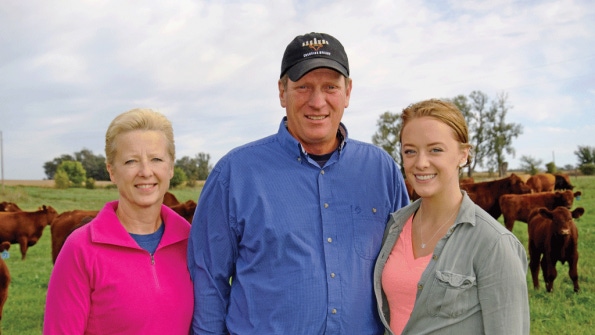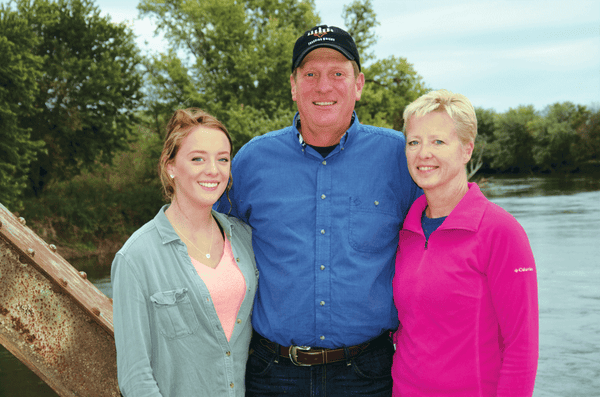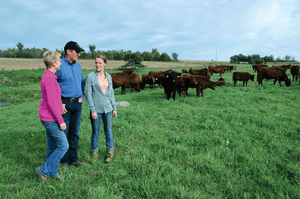Looking to boost forage production, Grant and Dawn Breitkreutz not only added cattle carrying capacity, but improved their soil and water profiles and cut operating costs. Meet the 2016 BEEF Trailblazer Award winners.Sponsored by John Deere
October 31, 2016

Minnesota bills itself as the “Land of 10,000 Lakes.” In actuality, there are 15,291 lakes of 10 acres or more in the North Star State, according to the Minnesota Department of Natural Resources (DNR). What’s more, the combined miles of all the state’s lake shoreline — 44,926 miles — add up to more than the combined lake and coastal shorelines of California.
So it’s little wonder that Minnesota places a high priority on water quality. And one of the latest wrinkles is a state mandate that all public waters (rivers, lakes, streams and wetlands) average a 50-foot buffer of perennial vegetation on their banks.
With seeding of the buffer areas required by Nov. 1, 2017, the mandate poses a challenge to many Minnesota landowners. But Grant and Dawn Breitkreutz, who farm along the Minnesota River near Redwood Falls, aren’t among them.
“Most of our buffers are 75 to 300 feet, and we had that in place before the mandate came down,” Grant reports.
It’s that kind of forward thinking that earned the Breitkreutz family the 2016 BEEF Trailblazer Award.
The beefed-up buffer strips are the result of mindset and management changes the married couple have made over the last two decades in a bid to boost their land’s forage production and carrying capacity. Along the way, they also improved the operation’s soil and water quality, and cut their operating costs.
“Because we farm along the creeks and rivers, we squared up our fields and put buffers along the waterways. We felt it was better to use that land for cattle production than for crop production. Since the buffer statute allows you to hay or graze those buffer areas, it won’t affect our operation at all as far as staying in compliance in the future,” Grant explains.
Cows graze every acre
The couple and their 17-year-old daughter, Karlie, operate Stoney Creek Farm, a three-generation cow-calf, farming and custom-feeding operation located 9 miles northwest of Redwood Falls. The operation’s 150 commercial Red Angus cows aren’t yarded unless they’re being worked or weather conditions merit it.
Instead, their cows intensively graze 450 acres of pastureland paddocks and 350 acres of no-till cropland interseeded for fall and winter grazing. They also graze public land through an agreement with the Minnesota DNR, which not only provides additional pastureland but also helps the state manage the health of its land.
In fact, cattle graze every acre of pasture- and cropland on Stoney Creek Farm. “We began experimenting with cover crops and fall grazing in 2002, and we started to see improved cattle gains, better cattle health and fewer problems in the fields with weeds and insects. So we just won’t go without planting a cover crop now,” Grant says. “We’re of the mindset that cattle on the ground improve soil health because they cycle nutrients directly to the soil, and the hoof action on the soil is beneficial as well,” he says.
Soon after they were married, the couple took over the farm, which consisted of 58 cows and 125 acres, from Grant’s parents in 1997. They began the transformation by splitting just one pasture in half to see how the cattle and grass would perform.

70 photos show ranchers hard at work on the farm
Readers have submitted photos of hard-working ranchers doing what they do best - caring for their livestock and being stewards of the land. See reader favorite photos here.
The experiment was a success and, over time, all their original and rented pastureland was divided into a total of 39 paddocks. In addition, they added more than 20,000 feet of aboveground waterline, 15 water tanks and three all-season waterers to allow cattle to graze cover crops on cropland.
“When we started rotational grazing, we had severe riparian damage to our stream banks and creek banks. When we situated our stock tanks farther away from those riparian areas and gave our grasses plenty of time to rest, our riparian areas healed up and the bare spots in the pastures filled in,” Grant says.
Cattle industry champions
Their conservation efforts have earned them wide recognition, including the 2010 Minnesota Outstanding Conservationist Award from the Minnesota Association of Soil and Water Conservation Districts, and 2015 Cattlemen of the Year recognition from the Minnesota State Cattlemen’s Association (MSCA). This year, Stoney Creek Farm was named one of seven regional Environmental Stewardship Award honorees. The overall winner will be named during the National Cattle Industry Convention in Nashville, Tenn., in February.

Dawn and Grant Breitkreutz, and their daughter, Karlie, operate a farming and ranching operation near Redwood Falls, Minn., called Stoney Creek Farm. Farming acres are 100% no-till with the use of cover crops, and cattle intensively graze every acre of crop and pastureland. Their stewardship management is drawing kudos from both industry and government sources.
But perhaps the most far-reaching contributions of the Stoney Creek Farm experience are its efforts to help to educate other producers and government land-use officials of the benefits of using cattle in resource management.
“The countless hours Grant and Dawn spend learning more about sustainable farming practices are matched by the number of hours they spend promoting these practices, and the culture of conservation, to fellow cattlemen as well as consumers,” says Ashley Kohls, MSCA executive director.
Kohls says the couple has presented information about cattle producers’ conservation efforts and public grazing in the state before more than 850 farmers, elected officials, state and federal agency heads and employees, and business professionals.
Among these, she says, have been Jason Weller, Natural Resources Conservation Service (NRCS) chief, and leaders and executives of numerous multistate and international companies, such as McDonald’s, Cargill, General Mills, Dannon, Monsanto, The Mosaic Co., Unilever and the Walton family.
“In 2015, Grant and Dawn served the Minnesota cattle community by participating in nearly 75 in-person meetings, 32 of which involved elected officials or government agencies; more than 25 media engagements; and over 4,000 miles traveled that year alone,” Kohls says. “Their continued commitment to the cattle industry in Minnesota is second to none, and they’ve also been a stop on the MSCA’s summer beef tour, which annually draws more than 800 people,” she says.
Cattle and wildlife
One important outreach, she says, is the couple’s work with wildlife managers in the North Star State. “In an effort to increase the access of public land to cattle farmers to graze, Dawn and Grant continue to work to educate waterfowl production area (WPA) and waterfowl management area (WMA) managers employed by the DNR and U.S. Fish and Wildlife Service about what cattle can do to help increase the quality of wildlife habitat on public land in Minnesota,” Kohls says.
She says the efforts have resulted in an increased emphasis in the state on the importance of grazing versus prescribed burning as a land management tool. “This past spring, Grant and Dawn were invited to speak to all the WMA managers in the state of Minnesota to increase awareness and educate them on the benefits of grazing. It would be a win-win for farmers, wildlife and taxpayers,” Kohls says.
Grant, who serves as chairman of MSCA’s Cow-Calf Council, sees such interaction as a vital role for the state’s beef industry. “In my area, what has really impacted the cow-calf producer is the purchasing by the state or other agencies of private land and gifting it to the DNR.”
That takes away the ability of the cow-calf producer to use that land, he says. “That’s why I’ve been working with the state so hard over the past eight years to get cows back out there on that land as a management tool.”
He says that controlled burning is the primary land management tool used by the DNR in his area. “We’d like to have the state manage its land the way we manage our land — with cattle. Cows don’t care if it’s windy or if it’s raining; they’re out there managing that land. And doing so not only will save the state money, but it will also help save the cattle industry we have here in the state,” Grant explains.
Winning converts
The Breitkreutzes appear to be winning converts to the concept. Jeff Zajac, the DNR area wildlife manager based in Redwood Falls, has worked extensively with the couple and is impressed with what he’s seen.
“The best way to describe the Breitkreutzes is ‘professional.’ I’ll describe what we want done with a piece of wildlife management area, grassland management-wise, and they always have a very good idea on how to manipulate the cattle in order to achieve the results we want. And they always follow through on what they say they’ll do,” Zajac says.
Of the 14,000 acres under his jurisdiction, Zajac estimates that about half are grassland acres, and perhaps less than 10% of those 7,000 grassland acres use cattle to improve wildlife habitat. He says prescribed burning remains by far the DNR’s most favored land management tool, but he likes the all-weather versatility that cattle grazing offers.
“The biggest thing we’ve been able to do with cattle is to suppress non-native grasses, such as smooth brome, bluegrass and other species that suppress the native plants we want — bluestem, indiangrass, switchgrass and native wildflowers. We can improve the health of the native prairie, because properly managed cattle are very good at suppressing those non-native grasses,” he adds.
Zajac says the Breitkreutzes perform another important service for him — technical advice. “If I need to know anything about cattle, fencing or grazing, they are usually the first people I’m going to call. And they’ve been really good ambassadors. They do a lot of outreach to wildlife professionals, as well as within their own cattle community, talking about their rotational grazing systems,” Zajac says.
Getting started
Like many farmers, Grant says he was initially hesitant about working with government agencies, especially on a voluntary basis. In fact, he says he researched the commitments that came with cost-sharing programs available under the NRCS for several years before he actually applied.
“When we finished our first contract under the NRCS Environmental Quality Incentives Program (EQIP), I was amazed how smoothly it worked. We built a great relationship with the people in our local NRCS office during that process, and we’ve done a lot of work with them since then,” he says.
EQIP is a voluntary program under NRCS that provides financial and technical assistance to agricultural producers to plan and implement conservation practices that improve soil, water, plant, animal, air and related natural resources on agricultural land and nonindustrial private forestland.
The first EQIP contract for the Breitkreutzes involved water development and fencing — specifically the installation of 2,900 feet of pipeline and two water tanks, and splitting a 47-acre pasture into nine parcels. Since then, the couple has participated in four more contracts.
Those early results also piqued their interest in holistic management classes, Grant reports. “It began with a three-day class at the University of Missouri led by Ian Mitchell-Innes from South Africa. He taught us how to use high-density grazing, and how to monitor pastures and keep records. We then went home and started working on it,” he says.
Today, Stoney Creek Farm uses 39 grazing paddocks, well over 20,000 feet of aboveground waterline, 15 water tanks and three more all-season waterers that allow the family to graze their cattle on cover crops in the fall.
Along with increased forage production, Grant reports they began to see improved water filtration on their soil, and less runoff. They also realized their pasture vegetation was filling in, producing more forage and appearing healthier.
“We then stopped spraying and fertilizing our pastures, and decided to do the same on the croplands. That’s what we’re diligently involved with now — working to change that soil structure on our cropland to what we have on the pastures,” he says.
Another benefit, he says, is improved cattle health. “Our overall cattle health has changed unbelievably. Our veterinary bill is today 25% of what it used to be, and we’re running close to three times as many cattle.
“I attribute a lot of that to getting the cattle out on healthy land and eating healthy feed. We used to yard cows probably five months of the year, now it is four to six weeks — or worst case, two months. In fact, that’s why we started custom feeding cattle again — we feed about 750 head each year — because we had these yards and barns that were no longer being used,” Grant explains.

Dawn, Grant and Karlie Breitkreutz take an impassioned approach not only to their farming and cattle operation, but also to working with state and federal wildlife agencies to help biologists understand the important role that cattle grazing plays in proper land stewardship, and to talking to consumers about the effort that goes in to producing safe, wholesome beef.
The couple say that changing their operational mindset wasn’t easy. “It was kind of lonely going through it at first, really lonely. People didn’t necessarily laugh at us, but comments were made that we were leaving three weeks of grazing on our pastures.
“Of course we were, but if we had grazed those extra three weeks in the fall, it would have cost us six weeks of grazing the next spring, plus add more weed pressure.” Grant says.
Dawn says it’s a constant learning process. “You get challenged every year as to whether you want to continue to do this or not. But when you look at the benefits of the changes you’ve made, that’s what really keeps pushing you to continue,” she says.
“Grant and I both say that we fought Mother Nature for a long time, and Mother Nature always won. Now we try to think how nature is designed, and we try to do the things that are in sync with it. It’s just a lot less fight,” Dawn says.
Among the resources beyond NRCS that the couple routinely use are the Redwood County Soil and Water Conservation District, the Holistic Management Institute, South Dakota Soil Health Coalition, the Burleigh County (N.D.) Soil and Water Conservation District, and Minnesota’s Sustainable Farming Association.
They retain close relationships with several holistic management practitioners and cattle specialists. One particularly valued resource is Eric Mousel, University of Minnesota regional educator for cow-calf management, in Grand Rapids.
“In my opinion, the Breitkreutzes are among the top operators in our region in terms of the way they manage their cattle and their resources. They are really cognizant of how all these things are related, and they incorporate that into their management program,” Mousel says.
More widely, however, Mousel lauds the role the couple play via their involvement in MSCA and with the University of Minnesota. “Grant and Dawn have done an outstanding job in promoting what we’re trying to do as an industry, both from the policy perspective and the general consumer knowledge perspective. Their contributions in those areas can’t be understated, and it’s absolutely amazing what they’ve accomplished,” he says.

Stoney Creek Farm’s Red Angus herd features both spring and fall calving programs, but most calves hit the ground in April and May. In late October, those spring calves go onto cover crops until December or longer. “Our calves don’t even look back for their mamas when they go on cover crops,†Dawn Breitkreutz says.
Grant says the operation’s ongoing goal is to keep improving the soil health. “We plan to keep learning and keep improving as we go. It’s actually fun to implement new practices and watch the results. I’m not a person who is tied to tradition; and Dawn didn’t grow up on a farm, so she wasn’t born and raised with the notion of ‘We’ve got to do it this way.’ She’s a great partner.”
That ethic has rubbed off on their daughter, Karlie. “Dad is passionate about creating something that is going to last,” she says.
He adds that the gates at Stoney Creek Farm are always open to anyone who wants to learn more about stewardship, including other producers who are looking to improve their conservation practices.
“Hopefully by doing what we’re doing here in retaining the integrity of our land, soil and water, there will be something here for our daughter, Karlie, if she wants to take over,” Grant says. Adds Dawn, “This is what God gave us, so we want to take the best care of it that we can, and that’s what we’re trying to do.”
Joe Roybal is BEEF editor emeritus and a freelance writer and editor. Contact him at [email protected].
You might also like:
Holmes and Fletcher classic cartoons
4 tips for grazing corn stalks this fall
What's the big deal about fetal programming?
Stunning fall snapshots from the ranch
HSUS is a fox in the hen house
About the Author(s)
You May Also Like



